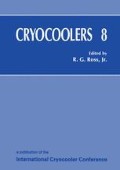Abstract
The Active Magnetic Regenerator (AMR) refrigerator, a test apparatus device used to demonstrate magnetic refrigeration, has yielded a high percentage of Carnot efficiency. The refrigerator employs two particle beds of a single magnetic material. A reciprocating superconducting magnet alternately magnetizes one bed at a time. When the magnet is stationary, a piston displacer forces a heat transfer fluid (helium) through the circuit. Two room temperature linear actuators drive the magnet and the displacer separately. Cooling loads are applied using resistive heaters attached to a central Cold Heat EXchanger (CHEX). Recent modifications of the AMR included installing new Hot Heat EXchangers (HHEXs) immersed in a liquid nitrogen (LN2) bath, to serve as a hot sink and provide a 77 Kelvin (K) environment.
During operation, heat is rejected to the LN2 bath, where the boiloff is measured using a nitrogen (N2) mass flow meter. The measurement of heat rejected allows the efficiency of the device to be determined. “Raw” efficiency is higher than 40% for some operating points. High “intrinsic” efficiency of the AMR cycle is demonstrated by exceeding 65% of Carnot, after correcting for measured apparatus losses. Cooling loads as high as 6 Watts (W) at 64 K cold end temperature have been achieved. The no-load temperature span of the single-stage magnetic refrigerator is about 48 K, when the hot end temperature is in the 82 K to 83 K range. AMR performance was characterized under varying experimental conditions including cycle time/period of operation, displacer circuit pressure, and displacer stroke. Experimental results show the correct performance trends. This paper describes the experimental results of running the AMR at 20 atmospheres (atm.) displacer circuit pressure, 7 Tesla (T) magnetic field, and 10 second (sec.) period, while varying displacer stroke/displacement.
Access this chapter
Tax calculation will be finalised at checkout
Purchases are for personal use only
Preview
Unable to display preview. Download preview PDF.
References
G. Green, J. Chafe, J. Stevens, and J. Humphrey, “A Gadolinium-Terbium Active Regenerator,” Advances in Cryogenic Engineering, vol. 35B. (1990), pp. 1165–1174.
J. A. Barclay, “The Theory of an Active Magnetic Regenerative Refrigerator”, Proceedings of the Second Biennial Conference on Refrigeration for Cryogenic Sensors and Electronic Systems. (1982). pp. 375–387.
C. B. Zimm and A. J. DeGregoria, “Magnetic Refrigeration: Application and Enabler for HTSC Magnets”, Superconductivity and its Applications. AIP Conference Proceedings, vol. 273, (1993), p. 471.
A. J. DeGregoria, L. F. Feuling, J. F. Laatsch, J. R. Rowe, J. R. Trueblood, and A. A. Wang, “Test Results of an Active Magnetic Regenerative Refrigerator”, Advances in Cryogenic Engineering, vol. 37B, (1992), pp. 875–882.
C. R. Cross, J. A. Barclay, A. J. DeGregoria, S. R. Jaeger, and J. W. Johnson, “Optimal Temperature-Entropoy Curves for Magnetic Refrigeration”, Advances in Cryogenic Engineering, vol. 33, (1988), pp. 767–775.
J. R. Trueblood, P. J. Claybaker, J. W. Johnson, and T. M. Stankey, “A Vertically Reciprocating NbTi Solenoid Used in a Regenerative Magnetic Refrigerator”, IEEE Transactions on Magnetics, vol. 27, (1991), p. 2384.
C. B. Zimm, E. M. Ludeman, M. C. Severson, and T. A. Henning, “Materials for Regenerative Magnetic Cooling Spanning 20 K to 80 K”, Advances in Cryogenic Engineering, vol. 37B, (1992), p. 883.
Author information
Authors and Affiliations
Editor information
Editors and Affiliations
Rights and permissions
Copyright information
© 1995 Springer Science+Business Media New York
About this chapter
Cite this chapter
Wang, A.A., Johnson, J.W., Niemi, R.W., Sternberg, A.A., Zimm, C.B. (1995). Experimental Results of an Efficient Active Magnetic Regenerator Refrigerator. In: Ross, R.G. (eds) Cryocoolers 8. Springer, Boston, MA. https://doi.org/10.1007/978-1-4757-9888-3_66
Download citation
DOI: https://doi.org/10.1007/978-1-4757-9888-3_66
Publisher Name: Springer, Boston, MA
Print ISBN: 978-1-4757-9890-6
Online ISBN: 978-1-4757-9888-3
eBook Packages: Springer Book Archive

